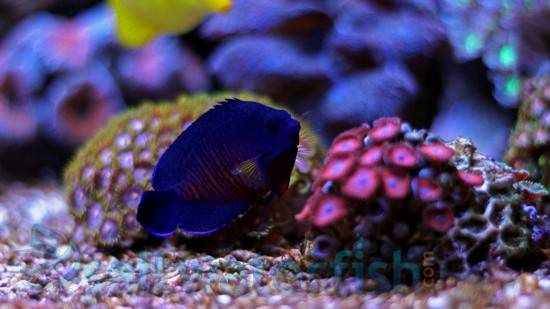Geometric Pygmy Hawkfish
Plectranthias inermis
(1 Reviews)

Geometric Pygmy Hawkfish
Plectranthias inermis
(1 Reviews)
{{ item.name }}
Size: {{ item.extra_field_3 }}
${{ getFormattedPrice(item.saleprice) }} ${{ getFormattedPrice(item.price) }}
To join the waiting list, click here
Free Shipping
With
$199.00
or more in Marine Life.
More details...
Geometric Pygmy Hawkfish Care Facts
| Care Level: | Easy |
|---|---|
| Temperament: | Semi-Aggressive |
| Diet: | Carnivore |
| Reef Safe: | Yes |
| Invert Safe: | No |
| Minimum Tank Size: | 20 gallon |
| Max Size: | 2 inches |
Geometric Pygmy Hawkfish (Plectranthias inermis): A Captivating Addition to Your Saltwater Aquarium
The Geometric Pygmy Hawkfish, scientifically known as Plectranthias inermis, is a captivating marine species that has gained popularity among saltwater aquarium enthusiasts. This product description aims to provide comprehensive information about the Geometric Pygmy Hawkfish, covering various aspects to help you make an informed decision when considering this species for your saltwater aquarium.
Habitat of the Geometric Pygmy Hawkfish: Exploring Coral-Rich Realms
The Geometric Pygmy Hawkfish originates from the coral-rich tropical waters of the Indo-Pacific region. It is commonly found inhabiting coral reefs, rocky outcrops, and crevices, where it seeks shelter and perches atop corals to hunt for small prey.
Reef Compatibility of the Geometric Pygmy Hawkfish: A Safe Haven in Your Reef
Geometric Pygmy Hawkfish is considered reef-safe, making it a suitable addition to reef aquariums. It generally does not harm corals or other invertebrates, making it a compatible choice for reef enthusiasts.
Size and Lifespan of the Geometric Pygmy Hawkfish: Small Marvels with Longevity
This species is relatively small, typically reaching a maximum size of 3 inches (7.6 cm). In captivity, with proper care, Geometric Pygmy Hawkfish can live for up to 5 years or more, providing aquarists with long-term enjoyment.
Diet of the Geometric Pygmy Hawkfish in Captivity: Culinary Preferences of Hawkfish
Geometric Pygmy Hawkfish are carnivorous predators. Their diet consists mainly of small crustaceans, tiny fish, and zooplankton. In captivity, they readily accept high-quality frozen and live foods, such as brine shrimp, mysis shrimp, and small marine pellets. Offering a diverse diet will help ensure their health and vitality.
Aquaculture and Availability of the Geometric Pygmy Hawkfish: Seasonal Marvels
Geometric Pygmy Hawkfish were not commonly aquacultured, and their availability to hobbyists depended on seasonal availability and imports from their natural habitat. It is advisable to check with reputable suppliers like Saltwaterfish.com for the most current availability.
Compatibility of the Geometric Pygmy Hawkfishwith Other Fish and Invertebrates: Peaceful Coexistence
Geometric Pygmy Hawkfish are generally peaceful but can be territorial with members of their species. When considering tank mates, choosing fish and invertebrates of similar size and temperament is essential. Here are five compatible tank mates:
- Firefish Goby (Nemateleotris magnifica): These colorful gobies share a similar size and peaceful temperament, making them suitable companions.
- Royal Gramma (Gramma loreto): Known for their striking colors and peaceful nature, Royal Grammas are an excellent choice as tank mates.
- Clownfish (Amphiprion sp.): Geometric Pygmy Hawkfish can coexist peacefully with clownfish, preferring anemone-filled reef environments.
- Blennies (Ecsenius sp.): Many blenny species are small and have unique personalities, making them compatible with the Geometric Pygmy Hawkfish.
- Cleaner Shrimp (Lysmata amboinensis): These shrimp species serve a dual purpose by keeping your tank clean and providing a fascinating addition to your aquarium.
Sexual Dimorphism of the Geometric Pygmy Hawkfish: A Challenge in Visuals
Geometric Pygmy Hawkfish do not exhibit sexual dimorphism, which means that males and females generally look alike and are challenging to differentiate based on appearance alone.
Juvenile to Adult Coloration Changes: A Transformation in Hues
Juvenile Geometric Pygmy Hawkfish often have brighter colors, including vibrant reds, oranges, and yellows. As they mature, their colors may become more subdued, with a preference for shades of red and pink.
Temperament: Inquisitive Observers
These hawkfish are known for their inquisitive nature and may perch on rocks and corals, observing their surroundings. They are generally peaceful towards other fish and invertebrates but can become territorial when defending their chosen perching spot.
Tank Requirements: Creating a Suitable Habitat
Minimum Aquarium Size: A tank with a capacity of at least 30 gallons is recommended to accommodate their swimming and perching habits.
Water Conditions:
- pH: 8.1 to 8.4
- Salinity: 1.023 to 1.025
- Water Temperature: 75°F to 80°F (24°C to 27°C)
- Water Flow: Moderate flow with gentle areas for perching.
Other Common Names: Recognizing the Geometric Pygmy Hawkfish
The Geometric Pygmy Hawkfish is known by various names, including the Dwarf Hawkfish and Spotted Hawkfish.
Why Choose the Geometric Pygmy Hawkfish from Saltwaterfish.com: Quality and Sustainability
Choosing Saltwaterfish.com as your source for Geometric Pygmy Hawkfish ensures you receive high-quality, healthy specimens with excellent customer support. The website provides valuable information, care guides, and customer support to assist you in creating an ideal habitat for your Geometric Pygmy Hawkfish. Additionally, Saltwaterfish.com often carries various marine species, allowing you to explore and select the best tank mates for your Geometric Pygmy Hawkfish.
In Conclusion: Beauty and Charm in Your Aquarium
In conclusion, the Geometric Pygmy Hawkfish is a fascinating addition to saltwater aquariums, known for its striking appearance and peaceful temperament. If you want to enhance your marine aquarium with a captivating species, consider the Geometric Pygmy Hawkfish, and trust Saltwaterfish.com to provide you with top-quality specimens and expert guidance for successful care and maintenance.
I am very pleased with this beautiful little fish, he hides among the rocks but does not bother my corals or other invertebrates , so far, lol.
Reviewed by: Chris Bolton on Feb. 8, 2016















